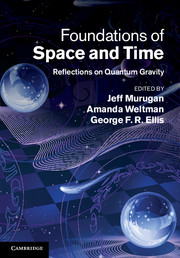Book contents
- Frontmatter
- Contents
- List of contributors
- 1 The problem with quantum gravity
- 2 A dialogue on the nature of gravity
- 3 Effective theories and modifications of gravity
- 4 The small-scale structure of spacetime
- 5 Ultraviolet divergences in supersymmetric theories
- 6 Cosmological quantum billiards
- 7 Progress in RNS string theory and pure spinors
- 8 Recent trends in superstring phenomenology
- 9 Emergent spacetime
- 10 Loop quantum gravity
- 11 Loop quantum gravity and cosmology
- 12 The microscopic dynamics of quantum space as a group field theory
- 13 Causal dynamical triangulations and the quest for quantum gravity
- 14 Proper time is stochastic time in 2D quantum gravity
- 15 Logic is to the quantum as geometry is to gravity
- 16 Causal sets: discreteness without symmetry breaking
- 17 The Big Bang, quantum gravity and black-hole information loss
- 18 Conversations in string theory
- Index
- References
4 - The small-scale structure of spacetime
Published online by Cambridge University Press: 05 August 2012
- Frontmatter
- Contents
- List of contributors
- 1 The problem with quantum gravity
- 2 A dialogue on the nature of gravity
- 3 Effective theories and modifications of gravity
- 4 The small-scale structure of spacetime
- 5 Ultraviolet divergences in supersymmetric theories
- 6 Cosmological quantum billiards
- 7 Progress in RNS string theory and pure spinors
- 8 Recent trends in superstring phenomenology
- 9 Emergent spacetime
- 10 Loop quantum gravity
- 11 Loop quantum gravity and cosmology
- 12 The microscopic dynamics of quantum space as a group field theory
- 13 Causal dynamical triangulations and the quest for quantum gravity
- 14 Proper time is stochastic time in 2D quantum gravity
- 15 Logic is to the quantum as geometry is to gravity
- 16 Causal sets: discreteness without symmetry breaking
- 17 The Big Bang, quantum gravity and black-hole information loss
- 18 Conversations in string theory
- Index
- References
Summary
Several lines of evidence hint that quantum gravity at very small distances may be effectively two-dimensional. I summarize the evidence for such “spontaneous dimensional reduction,” and suggest an additional argument coming from the strong-coupling limit of the Wheeler-DeWitt equation. If this description proves to be correct, it suggests a fascinating relationship between small-scale quantum spacetime and the behavior of cosmologies near an asymptotically silent singularity.
Introduction
Stephen Hawking and George Ellis prefaced their seminal book, The Large Scale Structure of Space-Time, with the explanation that their aim was to understand spacetime “on length-scales from 10−13 cm, the radius of an elementary particle, up to 1028 cm, the radius of the universe” [24]. While many deep questions remain, ranging from cosmic censorship to the actual topology of our universe, we now understand the basic structure of spacetime at these scales: to the best of our ability to measure such a thing, it behaves as a smooth (3+1)-dimensional Riemannian manifold.
At much smaller scales, on the other hand, the proper description is far less obvious. While clever experimentalists have managed to probe some features down to distances close to the Planck scale [43], for the most part we have neither direct observations nor a generally accepted theoretical framework for describing the very small-scale structure of spacetime. Indeed, it is not completely clear that “space” and “time” are even the appropriate categories for such a description.
- Type
- Chapter
- Information
- Foundations of Space and TimeReflections on Quantum Gravity, pp. 69 - 84Publisher: Cambridge University PressPrint publication year: 2012
References
- 5
- Cited by



